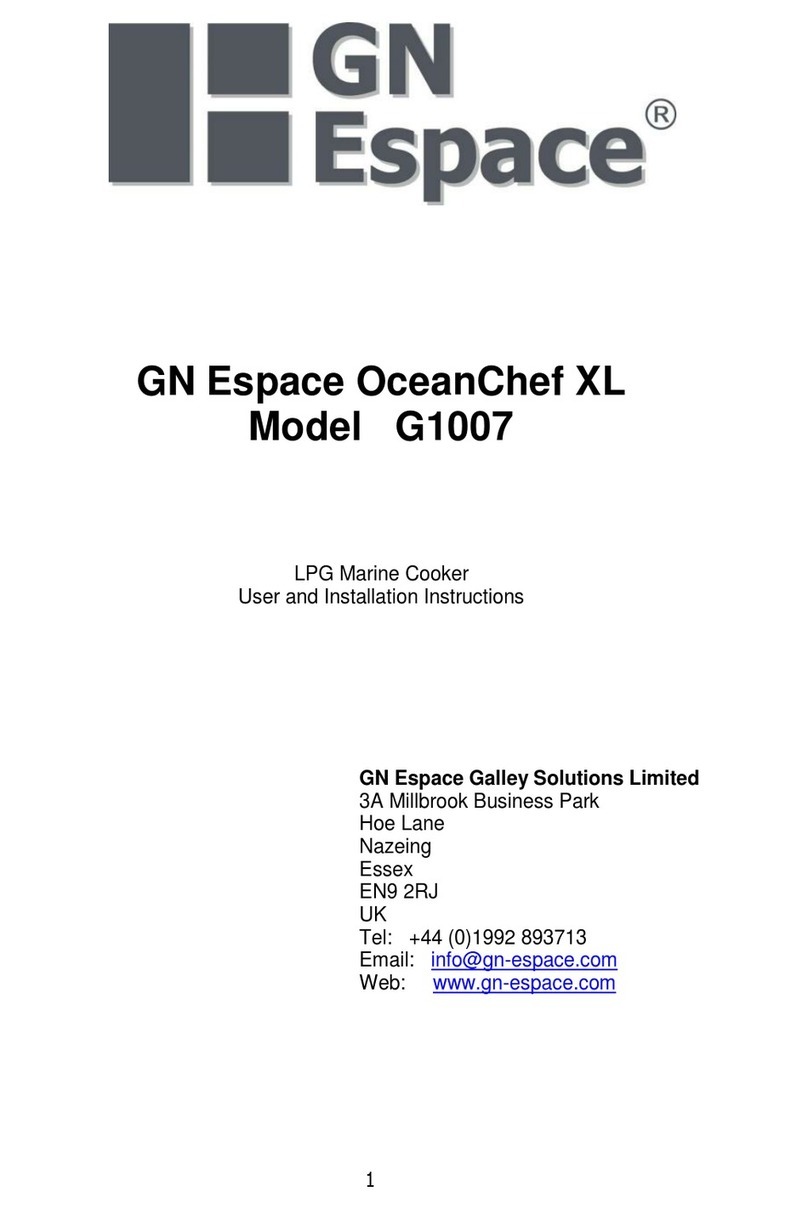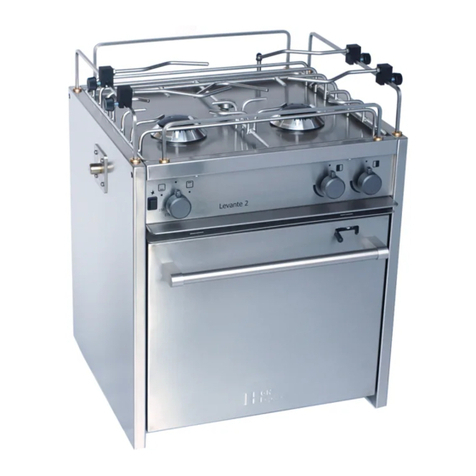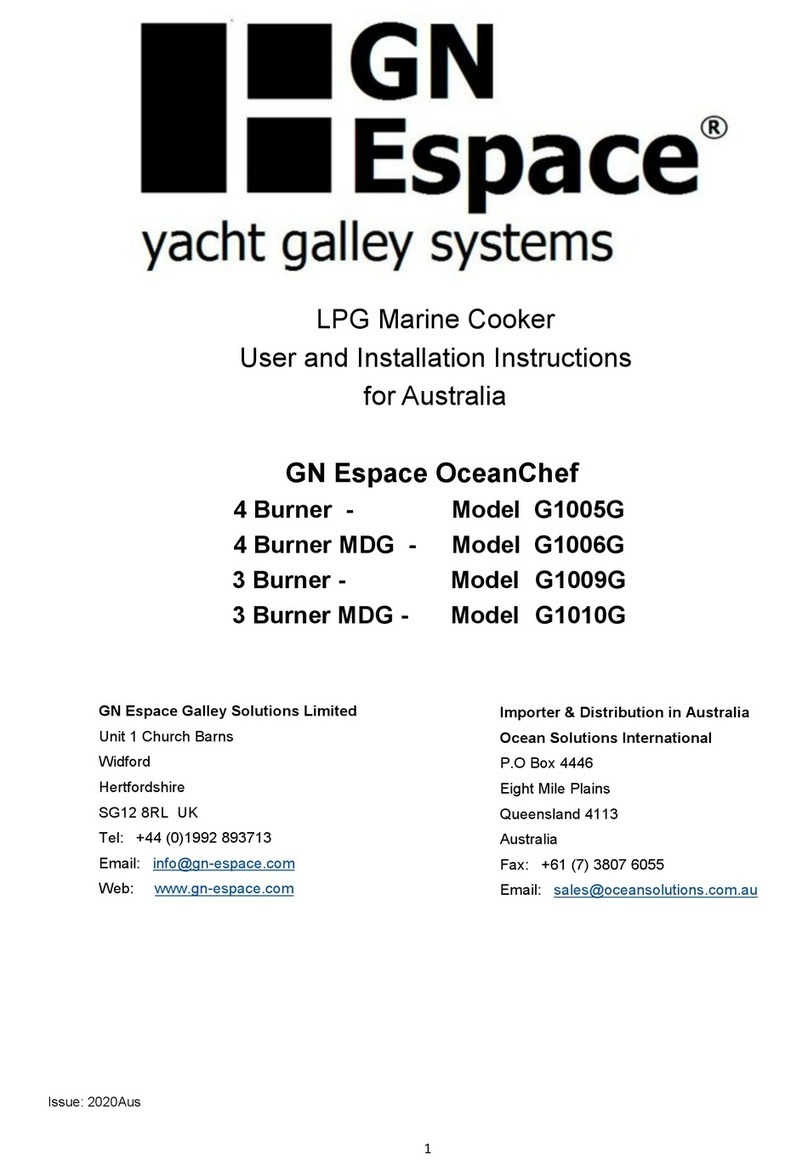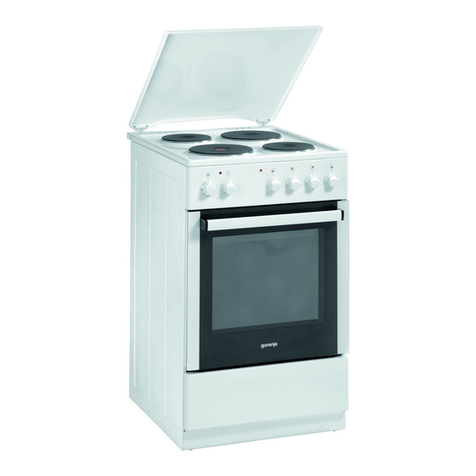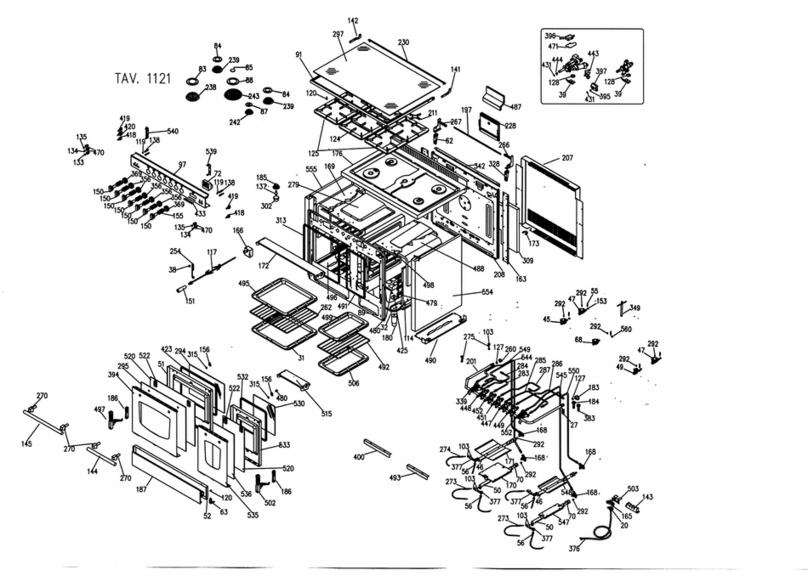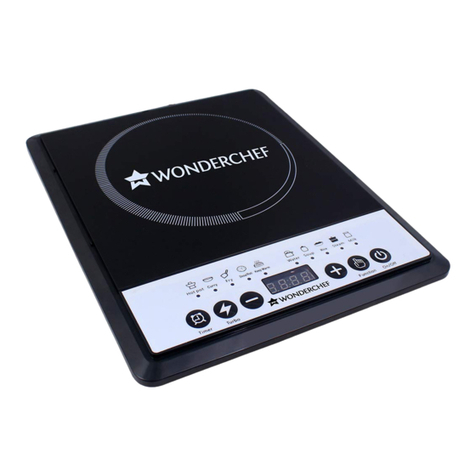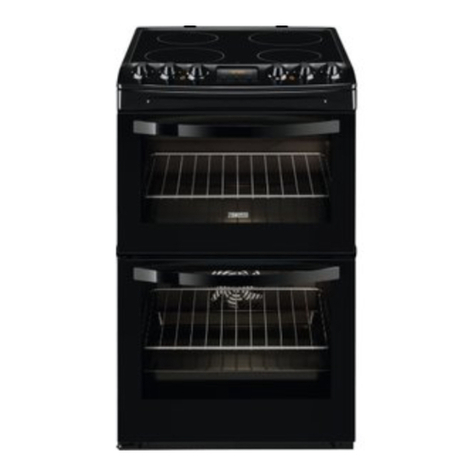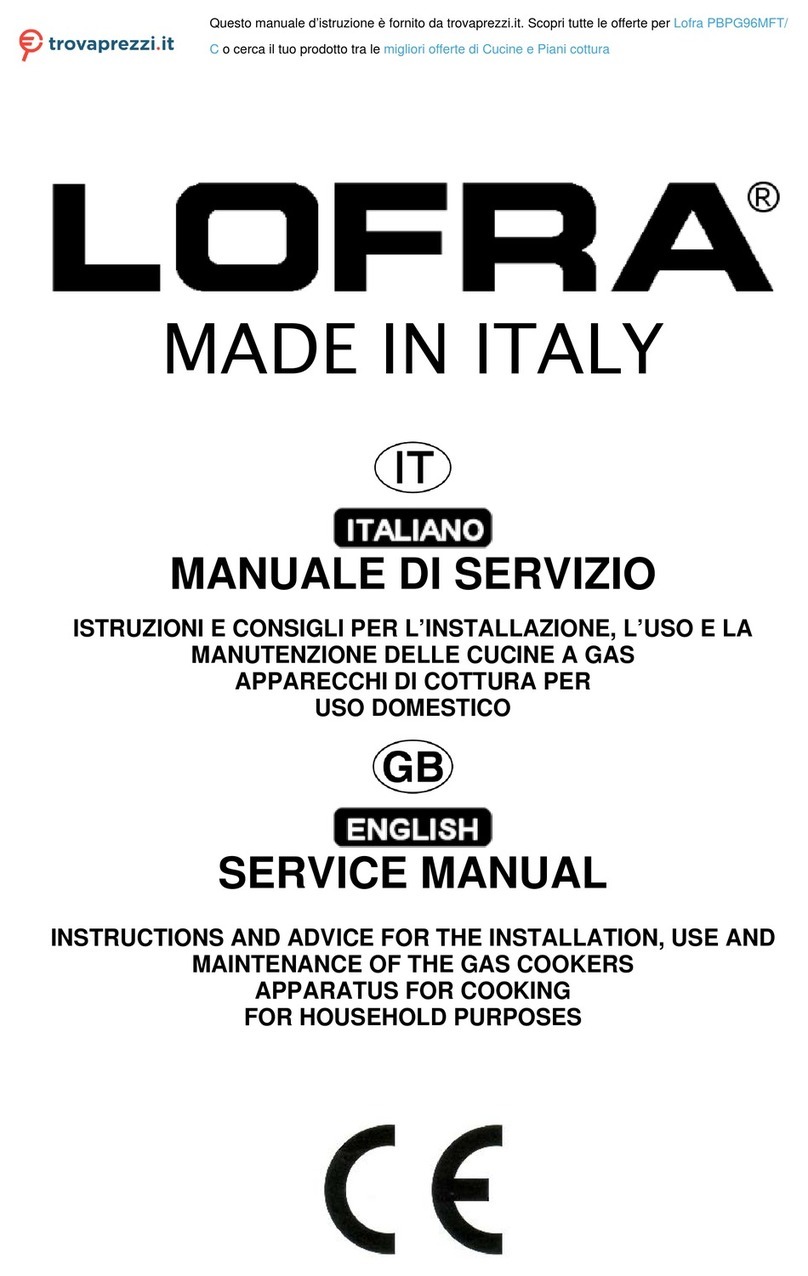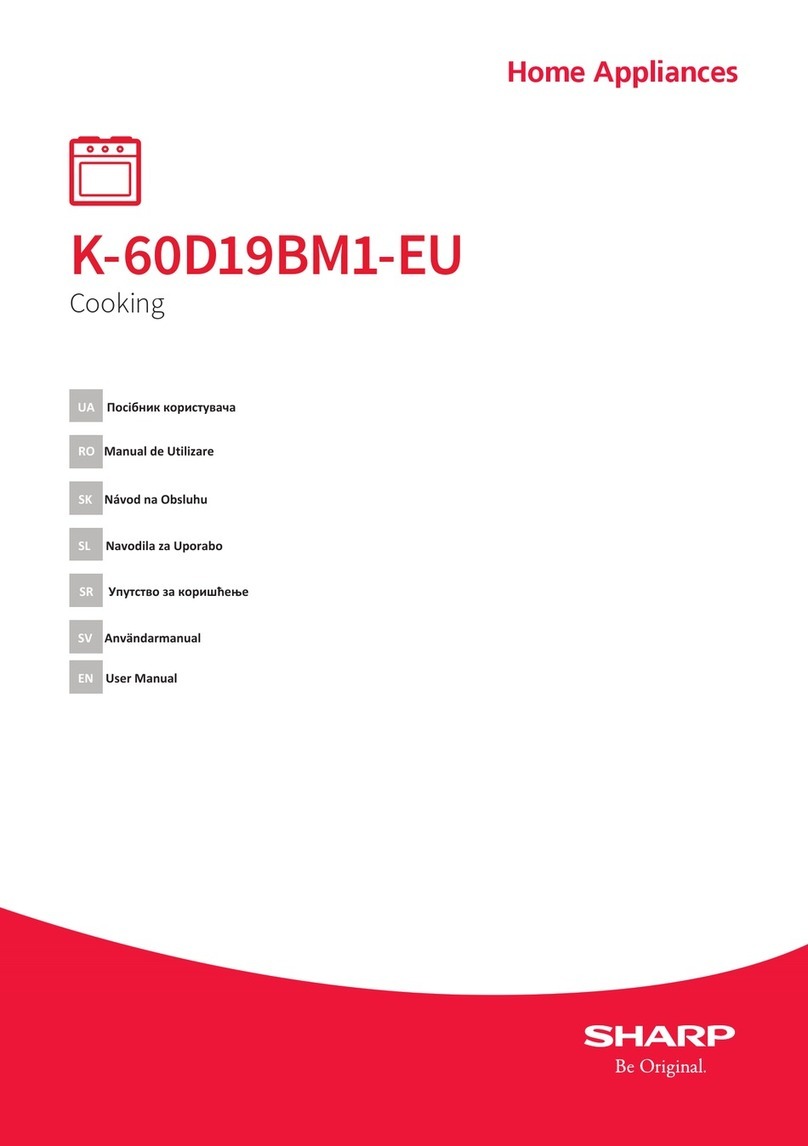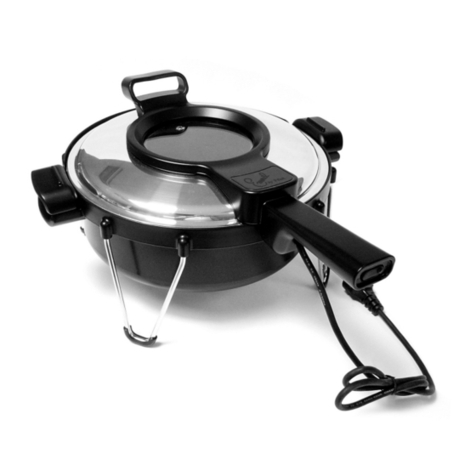GN Espace OceanChef XL Operating instructions

1
LPG Marine Cooker
User and Installation Instructions
for Australia
GN Espace Galley Solutions Limited
Unit 1 Church Barns
Widford
Hertfordshire
SG12 8RL UK
Tel: +44 (0)1992 893713
Email: info@gn-espace.com
Web: www.gn-espace.com
Importer & Distribution in Australia
Ocean Solutions International
P.O Box 4446
Eight Mile Plains
Queensland 4113
Australia
Fax: +61 (7) 3807 6055
Email: sales@oceansolutions.com.au
Issue: 2020Aus
GN Espace OceanChef XL
5 Burner - Model G1007G

2
IMPORTANT NOTICES
THE INSTRUCTIONS PACKAGED WITH THIS APPLIANCE CONTAIN
IMPORTANT INFORMATION ABOUT INSTALLATION AND USE.
TO BE INSTALLED ONLY BY AN AUTHORIZED PERSON IN
ACCORDANCE WITH LOCAL AND STATUTORY REGULATIONS
PROPANE GAS ONLY
‘DO NOT USE OR STORE FLAMMABLE MATERIALS IN THE
APPLIANCE STORAGE DRAWER OR NEAR THIS APPLIANCE
DO NOT SPRAY AEROSOLS IN THE VICINITY OF THIS APPLIANCE
WHILE IT IS IN OPERATION
DO NOT MODIFY THIS APPLIANCE
DO NOT USE THIS APPLIANCE AS A SPACE HEATER
If a gas leak is suspected due to the smell of gas or for any reason,
switch off the gas cylinder IMMEDIATELY. Extinguish all naked lights
including cigarettes. Do not operate electrical switches. Open all
doors and windows. Propane and butane gases are heavier than air
and will collect at a low level. YOU SHOULD IMMEDIATELY CALL A
LICENSED GAS FITTER/PLUMBER TO ASSESS YOUR INSTALLATION
LP (PROPANE) gas is heavier than air and any leakage will collect in
low level unventilated areas. Gas bottles shall be sited in a well
ventilated location as per Australian Standards.
BEFORE FIRST USE—AFTER INSTALLATION THE APPLIANCE MUST BE
TESTED FOR GAS SOUNDNESS AND SATISFACTORY OPERATION.
THIS APPLIANCE IS NOT SUITABLE FOR INSTALLATION WITH
AFTERMARKET LIDS/COVERS

3
CONTENTS
Page Number
Introduction 4
General Description 4
Product Overview (5 Burner Shown) 5
Using the appliance 6
For your safety 6
Lighting the appliance 7
Hob, grill, and oven ignition 7
Replacing the battery 7
Using the hob 7
Hob 7
Using and adjusting the pan fiddles (pan holders) 8
Using the grill 8
Grill 8
Using the oven 9
Oven 9
Cooking 9
Care and cleaning 10
General 10
Cleaning the hob 10
Cleaning the grill and oven 11
Maintenance and servicing 11
Installing the appliance 12
Positioning the cooker 12
Installation for gimballing 12
Electric 1.5v connection for ignition 13
Installation for ‘fixed installation’ (basic information) 14
Gas connection 14
Gas connection (Recreation Vehicles, Caravans) 14
Before first use 14
Troubleshooting 14
Spare parts 14
Technical specifications 15
Product dimensions 15
IMPORTANT NOTICE 15
ANNEX A Emergency procedures 16
ANNEX B Safe usage: Changing a cylinder 17
Installation for ‘fixed installation’ (Detailed Information) 18

4
Introduction
Thank you for choosing to buy a GN Espace marine cooker. This marine cooker has been designed and manufac-
tured to meet the required CE approvals. It is important that you understand how to use and care for the appliance
properly before you use it for the first time. This booklet is written with your safety in mind. Keep the booklet in a
safe place so that anyone who uses the appliance can read it. Pass on the booklet with the appliance to any future
owners
For detailed Emergency and Safe Usage procedures, refer to Annex A and Annex B at the end of these instruc-
tions.
Read all instructions and warnings before installing or operating this appliance!
Please spend the time to read this instruction booklet thoroughly. It will help you get the most from the many fea-
tures that this cooker has to offer. When installed and used correctly, we are confident that you will benefit from
many years of trouble-free use.
Tip: Keep this instruction booklet in a safe place so that anyone using the appliance can read it. Write the name,
model, and serial number, which are shown on the back of the appliance, into the instruction booklet. This will help
if you need to contact us about your cooker in the future.
General Description
The GN Espace marine cooker is a single cavity gas oven with grill and a 5 Burner hob. Each burner has an indi-
vidual gas safety thermocouple. It is designed to operate using an external LPG (Propane) regulated gas supply as
per Australian regulations at 2.75kPa.
The cooker is manufactured using materials which are designed for long life in a rugged marine environment.
The cooker is gimballed with a fixed width of 660mm. A fixed position gimbal lock is fitted.
The cooker is designed for gimballed or fixed installation. A fixed position gimbal lock is fitted. This cooker is also
suitable for a fixed installation on boats, recreational vehicles and caravans.
The oven and hob are designed around the dimensions of the Gastronorm professional catering equipment
(EN631). This allows an extensive range of interchangeable Gastronorm cookware to be used with the cooker, as
well as standard ovenware.
This appliance is to be installed in accordance with the regulations in force (AS/NZS5601) by a licensed gas fitter
as per the regulation of your state regulatory body. Failure to install the appliance correctly will invalidate any war-
ranty or liability claims and may lead to prosecution.
Read these instructions before installing and using the appliance.
IMPORTANT: This cooker is suitable for use with propane gas as defined in the AS/NZS standards. Ensure that
the appropriate regulator is fitted.
Warning. LP gas is heavier than air and any leakage will collect in low level unventilated areas. Gas bottles shall be sited in a well-
ventilated location as per Australian Standards.
Warning: If a gas leak is suspected due to the smell of gas or for any reason, switch off the gas cylinder IMMEDIATELY. Extinguish all
naked lights including cigarettes. Do not operate electrical switches. Open all doors and windows. Propane and butane gases are heavi-
er than air and will collect at a low level. YOU SHOULD IMMEDIATELY CALL A LICENSED GAS FITTER / PLUMBER TO ASSESS
YOUR INSTALLATION / APPLIANCE. Never check for leaks with a naked flame.

5
Gas types
Propane gas pressures can vary depending on the country of origin. This may necessitate a change to your pro-
pane tank regulator and a need to adapt your galley range to the new pressure. The chart below lists orifice and
by-pass sizes for Australian propane pressures. The information tabled below is also found on the data label af-
fixed to your appliance.
1. Burner / Thermocouple/ Spark ignition
2. Pan support lock
3. Pan support
4. Sea Rail
5. Gimbal lock bolt (gimbaled version only)
6. Gimbal lock bracket (gimbaled version only)
7. Pan clamps
8. Door lock
9. Gimbal pivot (gimbaled version only)
10. Gimbal pivot bracket (gimbaled version only)
11. Gimbal bracket retaining plate (gimballed version only)
12. Gas connection point (rear right)
13. Battery Housing Cover (front base)
14. Counterweight (on base) (gimbaled version only)
14. Rating Plate (rear panel)
Control panel
Hob Controls
Application Gas Type
Pressure Orifice Size (mm)
kPa Small Burner Large Burner X-Large Burner Grill Oven
Australia Propane 2.75 0.50 0.69 0.85 0.65 0.70
Nominal Gas Consumption of Burners in Mj/h 3.0 6.0 9.0 5.2 5.6
Product Overview
Oven / Grill Controller
Ignition

6
Introduction
This marine cooker has been designed and manufactured to meet the required CE approvals. This
It is important that you understand how to use and care for the appliance properly before you use it for the first time.
This booklet is written with your safety in mind. Keep the booklet in a safe place so that anyone who uses the
appliance can read it. Pass the booklet on with the appliance to any future owners.
For detailed Emergency and Safe usage procedures, refer to Annex A and Annex B at the end of these
instructions.
Rating Plate
This is situated at the back of the appliance. Do not remove the rating plate from the appliance as this may
invalidate the guarantee.
Using the appliance
CAUTION:
The use of a gas cooking appliance results in the production of heat, moisture and products of combustion in the
room in which it is installed. Ensure that the kitchen is well ventilated especially when the appliance is in use: keep
natural ventilation holes open or install a mechanical ventilation device (mechanical extractor hood).
Prolonged intensive use of the appliance may call for additional ventilation, for example opening of a window, or
more effective ventilation, for example increasing the level of mechanical ventilation where present.
CAUTION:
This appliance is for cooking purposes only. It must not be used for other purposes, for example room heating.
For your safety
• The appliance should not be operated when refueling the vessel or other appliances.
• The appliance must be sited in an area free from draughts which could affect combustion in a manner which
will allow a build up of unburned gas.
• All air vents must be opened and well maintained.
• Whenever operating the appliance ensure that the gas cylinder is correctly connected to the appliance gas
supply.
• When lighting any burner check that it has lit before you leave the appliance.
• When turning off a burner, do not leave the appliance until the flame has gone out.

7
Using the Appliance
Warning. All hob and burner flames should be predominately blue and without yellow tips.
Lighting the appliance
Hob, grill and Oven Ignition
Replacing the Battery
The battery for the ignition will usually last for
many months. If the ignition system doesn't work
you probably need to replace the battery.
The battery (1.5V AA size) is at the bottom rear
of the appliance. When you need to replace the
battery unscrew the battery cover by hand,
change the battery and replace the lid. Make
sure that the –ve end of the battery is held in the
spring.
You can light the burners with a match if needed.
Heat control
The hotplate control knobs turn anticlockwise from 'OFF' to 'HIGH' and then to 'LOW'. You can adjust
the heat by turning the control between the highest and lowest settings.
Burner sizes
Depending on the model the hotplate has two burner sizes to suit different types of cooking:
Semi Rapid (Normal) - use for everyday cooking.
Auxiliary (small) burner - use for simmering food such as soups and stews.
If you have any trouble lighting a hotplate burner turn all hotplate control knobs off and make sure
the hotplate burner parts have been replaced correctly.
Using the Hob
Hob
To Light Hob
1. Push in the control knob and turn it to the maximum set-
ting. Keep the control knob pushed in and press the igni-
tion button immediately.
2. When the burner has lit, release the ignition button, but
keep holding in the control knob for 15 seconds (to heat
the thermocouple).
3. Release the control knob and then turn it to the required
setting.
Warning. Press the ignition button immediately. If not pressed immediately then a build up of gas may cause the
flame to spread. The ignition should not be operated for more that 15 seconds. If after 15 seconds the burner has
not lit, stop operating the device and wait at least 60 seconds (1 minute) before attempting further ignition of the
burner.

8
Using and Adjusting the Pan Fiddles
WARNING : Accessible parts may get very hot when the grill is in use. Children should be kept away.
The cooker is fitted with a sea rail onto which the adjustable pan
fiddles (2 per burner) are fitted.
To attach the pan fiddle, open the thumbscrew on the clamp and
place the saddle onto the sea rail. When the fiddle is in the correct
position, tighten the thumb screw to hold the fiddle firmly in position.
Using the Grill — Important Grill should not be operated without grill deflector having been fitted (refer image below)
Grill Heat Control
The grill control has one heat settings. The control knob turns to the right from 'OFF' to
If the burner flame is accidentally extinguished during cooking, turn off the gas and wait at least one
minute before attempting to re-ignite.
Grill
To Light Grill
1. Open the oven door
2. Push in the control knob and turn it to
the grill setting. Keep the control
knob pushed in and press the ignition
button immediately.
3. When the burner has lit, release the
ignition button, but keep holding in
the control knob for 15 seconds (to
heat the thermocouple).
4. Leave the grill door partially open
when you are using the grill.
WARNING : Press the ignition button immediately. If not pressed immediately then a build up of gas may cause
the flame to spread.
If the burner flame is accidentally extinguished during cooking, turn off the gas and wait at least one minute before attempting to reignite.
Fitting the grill deflector.
A grill deflector (supplied loose with the appliance) is to be fitted to
the appliance in the designated location prior to operating the grill.
This deflector is designed to minimise heat to the fascia area where
the control knobs of the appliance are located.
When operating the grill has been completed please understand that
the deflector will be ‘HOT’ - Do not remove the grill deflector until
such time that the metal has cooled down sufficiently to be handled.

9
Using the Oven
Shelf Positions
The oven has three shelf positions—top (for grilling), middle and lower.
Heat zones
When using the oven you will find that the top shelf of the oven cavity is hotter that the lower shelf. The oven temperature that you have
chosen will be on the middle shelf.
You may therefore have to adjust the temperature or cooking time depending on which shelf level you are using in the oven.
1. To remove the oven shelf pull it out
until it reaches the safety stop.
2. Slightly angle the shelf upwards and
pull out of the runners.
The oven is supplied with two removable oven shelf pan holder as standard.
Additional oven shelf pan holders are available as optional accessories.
Preheating
Important: when you need to preheat the oven, we recommend you do so for at least 15 minutes (20 minutes when cooking large amounts of
food). Placing cold food in an oven that has not been pre-heated considerably reduces the cooking performance.
Oven thermostat
Immediately initiate repair or replacement of the thermostat if an abnormal drift of oven temperature occurs during cooking.
Oven
To Light Oven:
1. Open the oven door.
2. Push in the control knob and turn it to the maximum
oven setting. Keep the control knob pushed in and
press the ignition button immediately.
3. When the burner has lit, release the ignition button,
but keep holding in the control knob for 15 seconds
(to heat the thermocouple)
4. Release the control knob and then turn it to the re-
quired setting.
5. Wait until the burner is showing large flames.
6. Close the oven door.
WARNING : Press the ignition button immediately. If not pressed immediately then a build up of gas may cause
the flame to spread.
If the burner flame is accidentally extinguished during cooking, turn off the gas and wait at least one minute before attempting to re-ignite.
To turn off any burner (hob, grill and oven)
1. Push in the control knob and turn it to the off position. This is shown by a large dot.
Cooking
The oven is designed to accept standard and Gastronorm cooking trays which are available in a number of sizes and depths.
There are 3 shelf positions.
Always pre-heat the oven before placing cold food in the oven.
The oven is capable of reaching full cooking temperature from cold, in approximately 20 minutes.
When using the hotplate, care must be taken to ensure that pans do not overlap the edges of the hotplate. When circular pans are used the
minimum diameter shall not be less than 120mm and the maximum shall be 180mm, on all the burners.
Oven Temperature Control: MINIMUM SETTING AVG. TEMP = 112oC / MAXIMUM SETTING AVG. TEMP = 236oC

10
Care and Cleaning
General
Clean your appliance regularly using a cloth that has been wrung out in hot soapy water (i.e. hot water with dishwashing liquid).
Rinse and polish it dry using a soft cloth.
Do not use any polishes, caustic cleaners, abrasives, washing soda or soap except those recommended. When you remove
parts of your appliance for cleaning do not plunge them into water whilst they are very hot as this may damage the finish of the
parts.
Cleaning the Hob
• You can remove the pan support, burner caps and burner rings to clean them. Take care not to damage the spark electrodes
and thermocouples.
• For hygiene and safety reasons you must keep this gas appliance clean. A build up of fat or other foodstuff could cause a fire.
• Try to clean up spills and splashes as soon as possible. But be careful as parts of the cooker will be hot.
• You can wash the removable parts in very hot soapy water.
• Make sure that the electrode and the hole and slots in the ring are not blocked with food or cleaning materials.
• Clean the burner rings by soaking them in very hot soapy water.
• You can remove any stubborn stains by scouring with a soap-filled scrubbing pad.
• If you look after the burner rings in this way they will stay reasonably clean. However the surface will dull with time.
• Aluminium-based saucepans can leave shiny metal marks on the pan supports.
• Clean the pan supports regularly.
• After cleaning the appliance parts, dry them thoroughly before you put them back.
Pan Support - Removal and Replacement
1. Undo the holding nut in the centre
of the hob.
2. Lift off pan support.
Hob Burners - Removal and Replacement
1. Remove the pan support
2. Grip the burner cap and rotate it
anticlockwise through ¼ turn and lift
off.
3. Lift off the burner cap and burner
ring.
4. Reverse procedure to replace. Make
sure that the holes on the ring align
with the thermocouple and spark
electrode.
5. Do not try to force the ring on to the
body Check for ignition.
6. If a burner will not light then you need
to check the ring and cap positions.

11
Cleaning the Grill and Oven
General
Regularly clean the oven cavity and door while they are still slightly warm. This way you can easily remove any splashes and spills.
Wipe with a cloth that has been wrung out in hot soapy water.
To avoid the possibility of the shelf jamming, ensure that all the entrance holes to the shelf runners are kept clean and clear of spillage.
Do not clean the grill burner or oven burner itself. The burners are designed to be self cleaning. Cleaning the burners may cause the
holes in the burner to become blocked preventing them from operating correctly.
Maintenance and Servicing
In addition to regular cleaning of the appliance, it is recommended that servicing is carried out once a year by a suitably qualified engineer.
The manufacturer shall make servicing instructions available, on request, to competent persons to enable the appliance to be maintained in a
safe working condition.
WARNING : Any servicing or maintenance work carried out by an unauthorised person will invalidate the
manufacturers warranty and could result in a dangerous situation.

12
Installing the Appliance
It is a legal requirement that all gas appliances are installed by competent persons qualified in accordance with the local and Australian
regulations (Check with your individual state’s regulatory body for qualified gas fitters to complete an installation of your appliance to the
appropriate regulation standard in force at the time of installation ). Failure to install the appliance correctly could invalidate any warranty
or liability claims and lead to prosecution.
The appliance shall be installed in accordance with the local and Australian standards in force at the time of installation.
Particular attention shall be given to the requirements regarding ventilation.
This appliance may not be installed in a room containing a bath or a shower.
Read these instructions before installing or using the appliance.
Ventilation
This appliance is suitable for installation into boats, recreational vehicles and caravans. The national standards regarding ventilation
must be adhered to.
The use of this cooker results in the production of heat and moisture in the area in which it is installed. Ensure that the galley is well
ventilated. Keep natural ventilation passages open or install a mechanical ventilation device.
Loose items supplied with cooker (Qty / Description)
1x Instruction book
1x Oven wire shelf
2x Oven frames
1x Grill deflector
1x GN 1/1 pan
1x GN 1/1 wire trivet
10 x Pan fiddle clamps (depending on model)
4 x Sea Rails (1 front rail (low height), 3 side and back rails)
1x 1.5V Battery size AA
2 x Gimbal pivot brackets
1x Gimbal lock bracket
1 x Counterweight (if not supplied fitted)
Positioning the Cooker
A horizontal distance of 200mm must exist between the edges of the appliance and any combustible material unless that material is protected
by a layer of non combustible material. All combustible material such as curtains and shelves must be kept well clear of the appliance. Any
fittings such as a cupboard above the cooker must have a minimum clearance of 550mm between the fitment and the top of the pan support.
Installation for Gimballing
The cooker is designed to be installed into a ‘cooker box’ sited between two vertical walls using the two gimbal mounting plates fitted to
appropriate wooden blocks held using M6 bolts or screws.
The cooker is set up to fit into a 660 mm gap.
To install:
1. Use the diagram below to establish the relative positions of the gimbal pivot facing bracket and gimbal lock facing bracket (on left
wall).
2. Identify a suitable position to mount the left and right hand gimbal pivot and the gimbal lock facing bracket.
3. The gimbal and gimbal lock facing brackets should be located in such a position to allow the cooker to gimbal perpendicular to the
vertical furniture walls and also to be horizontal plane.
4. Suitable mounting blocks for the gimbal pivot facing bracket and gimbal lock facing bracket in order to create a 660 mm wide gap need
to be fabricated. See pictures below.
5. Attach counterweight to base of cooker (if not already fitted) with screws provided. Lift cooker into position on the gimbal pivot facing
bracket. Attach the securing caps onto the gimbal pivot brackets using the screws provided.
6. Lift cooker into position on the gimbal pivot facing bracket. Attach the securing caps onto the gimbal pivot brackets using the screws
provided.
7. Use the diagram below to establish the relative positions of the gimbal pivot facing bracket and gimbal lock facing bracket (on left wall)

13
Electric 1.5v connection for ignition
The battery holder and battery are supplied as loose component when the cooker delivered. This is supplied
loose for transportation reasons. Fix the battery holder to the base of the cooker using the provided screws into
the pre-drilled holes. Connect the cable to the battery holder using the push connections. The battery holder is
connected to the appliance using the supplied electrical cable.
The battery (1.5V AA size) is located in the housing. When you need to replace the battery unscrew the battery
cover by hand, change the battery and replace the lid. Make sure that the –ve end of the battery is held in the
spring.

14
Installation for Fixed Installation (Boats, Recreational Vehicles and Caravan)
The cooker is set up to fit into a 625mm gap (this allows 2.5mm either side) with the gimbal pins removed. The cooker is designed to be
mounted and held safely in place by means of a set of specifically designed runners (available from GN Espace as an accessory - sup-
plied separately) fitted to the cooker box base. A ventilation gap of at least 30mm must be provided at the back edge of the cooker.
Gas Connection
The Cooker is fitted with an 3/8” SAE45 male flare fitting at the rear of the appliance. The appropriate sized connector to suit the hose
needs to be fitted. The final connection will be by means of an approved flexible hose, (Flexible hoses used in the installation of the
appliance must be Australian Certified hoses, minimum class B or D in accordance with AS/NZS1869). It must have a length
which does not exceed 1 Metre and the minimum length is 600mm, be marked to identify its suitability for use with LPG appliances.
Flexible hoses should not pass through bulkheads, decks or partitions unless protected from abrasion. Flexible hoses should not be
subjected to temperatures above 50°C
Note: Installation hose assemblies are not part of the appliance supply and are to be supplied and fitted by the appropriately
licensed gas technician.
After installation the appliance must be tested for gas soundness.
Before First Use
• Remove all accessories and packing from within the oven and before the first use, clean the interior and all fittings with a soap
and warm water solution.
• To burn off lubricants used in manufacturing heat the oven to 200°C and leave for 30 minutes before introducing the initial
batch of food to be cooked.
• To burn off lubricants used in manufacturing the grill use the grill for 15 minutes.
Troubleshooting
If you feel that the oven, grill or burners are not getting hot enough this is likely to be because the cooker is
not getting enough gas. Please measure the gas pressure at the appliance and the regulator to ensure that it
is as stated in the technical specification below e.g. 2.75kPa / 27.5mbar. If necessary, replace the regulator and
clean gas system.
Spare parts
Please contact us if you have a technical problem or need a spare part. When you report a problem try to describe the
nature of the fault. Always give your appliance's full name, model and serial number, along with your details. Call with, or
send information to Ocean Solutions International.
Sales@ocean Solutions.com.au
+61 (0)7 3807 6033
Appliance Model Number:
Appliance Serial Number:
Appliance Purchased From:
Fixed Installation
For a fixed installation the specifically designed runners (accessory-supplied separately) are required. The oven is designed to be mount-
ed and held safely in place by means of a set of runners on the base of the oven which are specifically designed to slide onto a matching
set of runners fixed to the floor of the floor of the furniture cavity. The oven is secured by means of two screws at the front of the sliders.
For detailed instructions refer page 15

15
Technical Specification
The appliance is for use with LP gas.
Propane (G31) 2.75kPa / 27.5 mbar
Oven
Internal dimensions (H x W x D - mm): 260 x 535 x 390
Number of tray positions: 3
5 Burner
Total Heat Input (kW/g/h) 13.4 kW (983 g/h)
Hotplate burners 1 x 3.0kW (226g/h) 3 x 1.9 kW (140 g/h),1 x 1.1 kW (80 g/h)
Grill burner 1.7 kW (125 g/h)
Oven burner 1.9 kW (140 g/h)
Injector size (mm)
Hotplate burners
Small burner 0.50
Medium Burners 0.69
Large burner 0.85
Grill burner 0.65
Oven burner 0.70
Weight (cooker only) 37 kg Weight complete with fittings 41 kg
Product Dimensions
IMPORTANT NOTICE
In line with our continuing policy of research and development, we reserve the right to alter models and specifications without prior notice.
Gas connection
at right rear of
the appliance

16
This instruction booklet is accurate at the date of printing, but will be superseded if specification or appearance are changed.
Information Safety Information for users
ANNEX A Emergency procedures
Leakage
• If LPG leakage is detected or suspected, the following action should be taken immediately.
• Shut off the LPG supply at the cylinder valve(s).
• Extinguish naked flames and other ignition sources (heaters, cooking appliances, pilot lights, cigarettes etc.).
• Do not operate electric switches.
• Ventilate the area with a through draught.
• Evacuate the area if possible.
If leakage is from a cylinder and cannot be stopped, move the cylinder to where LPG can disperse away from the vessel
(and other vessels). Take care not to spill LPG while moving the cylinder.
Do not use an installation that has leaked until it has been checked by a competent person.
Fire from an LPG leak
If an LPG leak has ignited, action should be taken in accordance with (a) or (b) as appropriate.
If the vessel is moored:
• Alert everyone in the area and evacuate if possible.
• Call the fire brigade, if practicable.
• Do not attempt to extinguish any flame unless it is safe to do so. Shut off the LPG supply before attempting to extin-
guish the flame. After shutting off the LPG supply, extinguish any free burning materials with extinguishers or water.
• Do not reuse the installation unless it has been checked by a competent person.
If the vessel is offshore:
• Alert everyone on the vessel.
• If it is safe to do so, shut off the gas supply.
• Extinguish any free burning material with extinguishers or water.
• Do not reuse the installation unless it has been checked by a competent person.
Fire close to an LPG cylinder:
WARNING: Cylinders exposed to fire can explode.
If there is a fire near to an LPG cylinder, the following action should be taken.
• Alert everyone in the area and evacuate if possible.
• Call the fire brigade if practicable.
• If it is safe to do so, shut off the gas supply and move the cylinder to a safe place in the open. If the cylinder cannot
be moved, keep it cool with wet blankets and spraying with water.
• Do not reuse the installation unless it has been checked by a competent person.

17
ANNEX B Safe usage : Changing a cylinder
The following safe practices should be complied with when changing a cylinder.
1. Ensure that any manually operated valves on both the full and empty cylinder are turned off before changing.
Replace the plastic safety cap or plug on disconnected cylinders.
2. Store, transport and use cylinders vertically with the valve uppermost.
3. Do not use a cylinder if the cylinder, valve or regulator are damaged. Return the cylinder to the supplier.
Do not attempt to repair the fault.
4. Before changing the cylinder, extinguish any fire, flame or source of ignition, including cigarettes and pilot lights.
5. Joints should be firm and gas tight. If a leak is suspected, after changing a cylinder and opening the valve,
check the cylinder valve with an ammonia free leak detection fluid. Do not use a naked flame for testing.
6. If a leak cannot be stopped, move the cylinder to a safe place in the open, ensuring that the leaking LPG is
dispersed safely.
7. Ensure that replacement cylinders are appropriate for the installation.
8. Ensure that the regulator is appropriate for the appliance and use in accordance with the manufacturer’s
instructions.
9. Ensure that sealing washers, if required, are sound and correctly positioned prior to connecting.
Mating surfaces of connections that require metal to metal sealing should be clean and undamaged.
Do not use damaged valves or connections.
10. Use the correct size of spanner for connections, and tighten firmly. Self-sealing valves should be connected in
accordance with the manufacturer’s instructions.
11. Regulators fitted with integral relief valves should be ventilated to the open, away from sources of ignition.
12. Ensure that all appliance taps are turned off before reconnecting cylinders that have been closed, or connecting
replacements.
13. Light appliances without an ignition device, by applying a match or taper to the burner before turning on the
supply.
Refuelling LPG powered vessels
As well as taking normal precautions against spillage, smoking or naked lights, ensure that all gas burners are turned off and
the permanent pilot lights extinguished. Disable automatic ignition systems when refueling.
Appliance usage
The following should be complied with when using the appliance.
Operation and maintenance of the appliance should be carried out in accordance with the manufacturer’s instructions.
Ventilate the area. Do not obstruct ventilator openings. Do not use this cooking appliance to heat the area
WARNING: Non room-sealed fuel burning appliances consume oxygen and can release combustion products into
the vessel.
Check flexible hoses regularly. Replace if cracked or otherwise deteriorated. Ensure that the ends of
replacement hoses are secure and gas tight.
Ensure that the LPG system is regularly tested for leakage. Connections should be checked by:-
Routine observation of a bubble tester installed in the cylinder locker or housing, or
routine observation of a pressure gauge in the high pressure side of the system, or
testing with leak detection fluid, with the appliance burners turned off and the main shut off valve open.
WARNING: If there is a leak discovered in the LPG system, close the cylinder valve and ensure that it
is repaired by a competent person.
WARNING: Do not use solutions containing ammonia to detect leaks.
WARNING: Do not check leaks with a naked flame.
Check flues at least once a year.
Check the cylinder locker is not damaged so as to allow the escape of leaked LPG.
Check the cylinder locker drain is not blocked or damaged.
Note: For side opening cylinder lockers installed in accordance with AS/NZS5601, check the effectiveness of any seal.

18
Installation Instructions for the Built-in and Slot-in fixings of
GN Espace ovens and cookers (all models)
Installation for Fixed Installation (Boat, Motor-Home, Caravan)
A ventilation gap of at least 30mm must be provided at the back edge of the oven.
A minimum gap of 3mm on either side of the unit is required and the material in the cavity should be a non-
combustible such as sheet metal.
The adjacent materials must be non combustible and able to resist temperatures of at least 100 Celsius
The appliance is designed to be mounted and held safely in place by means of a set of runners on the base of the
oven which are specifically designed to slide onto a matching set of runners fixed to the base of the furniture cavity.
Once slid in position the oven is secured by means of two screws at the front of the sliders.
The unit is not designed to have a cover placed over it, and will cause a hazard if the unit is covered.
The diagram above shows the drill locations for the runners (shown right) on the cabinet base which is common
to the Levante, OceanChef and OceanChef XL models.
Remote location of the 1.5V ignition battery holder
For models intended for build-in installation, the battery holder and battery are supplied as loose component
when the cooker is delivered.
Position the battery holder in an accessible location within reach of the cable. This may require feeding the cable
through a drilled hole into the adjacent cupboard.
Ensure that the cable is protected from chaffing. Use screws to fix the battery holder firmly in place.
Connect the cable to the battery holder using the push connections. The battery holder is connected to the appli-
ance using the supplied electrical cable.
The battery (1.5V AA size) is located in the housing. When you need to replace the battery unscrew the battery
cover by hand, change the battery and replace the lid. Make sure that the –ve end of the battery is held in the
spring.

19
NOTES

20
GN Espace cookers are fitted as original equipment by leading yacht builders including:
Yacht Galley Systems
GN Espace is a UK-based specialist galley company, whose innovative designs and integrated systems are now
seen as the benchmark for the galleys of modern cruising yachts.
Increasing numbers of the world’s leading yacht builders now specify GN Espace equipment for their galleys.
The superior build quality and high performance of the GN Espace marine cookers are at the core of these
galleys. The Waterstation sinks, our cookers and our other innovative galley storage equipment all come with
built-in fiddles, ensuring that everything stays exactly where you need it to. These systems have been designed
around the Gastronorm catering container, which forms the building block of our integrated systems.
These systems have been designed to transform the galley space into an ergonomically more functional and
significantly safer place to prepare and cook food whilst at sea.
Based around the Gastronorm container, a fundamental piece of equipment in professional catering
environments, we have designed a fully integrated cooking, food preparation and storage concept which provides
increased working space in confined quarters as well as greater flexibility, safety and convenience
Allures
Alubat
Amel
Boreal
Catana
Contest
Cornish Crabbers
Discovery
Euphoria
Garcia
Gunfleet
Hallberg Rassy
Hylas
Lyman Morse
KM Yachts
Kraken Yachts
Najad
Oyster Marine
Rustler
Seaward Nelson
Solaris
Southerly
Spirit Yachts
X-Yachts
This manual suits for next models
1
Table of contents
Other GN Espace Cooker manuals
Popular Cooker manuals by other brands
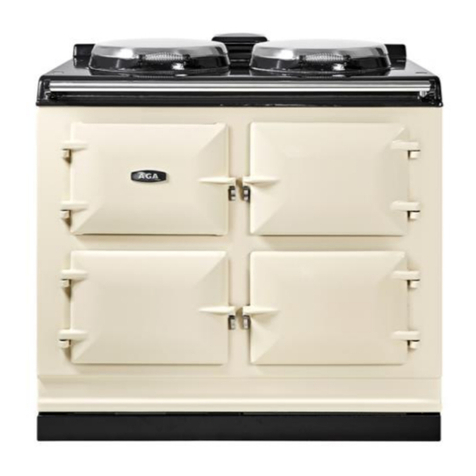
AGA
AGA 7 Series owner's manual
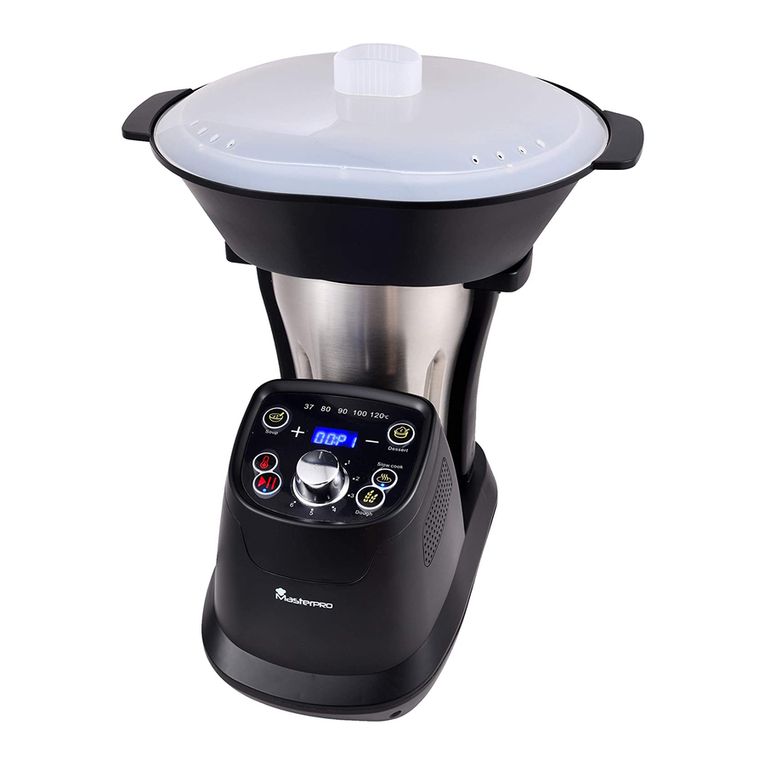
Carlo Cracco
Carlo Cracco MasterPro BGMP-9123 manual
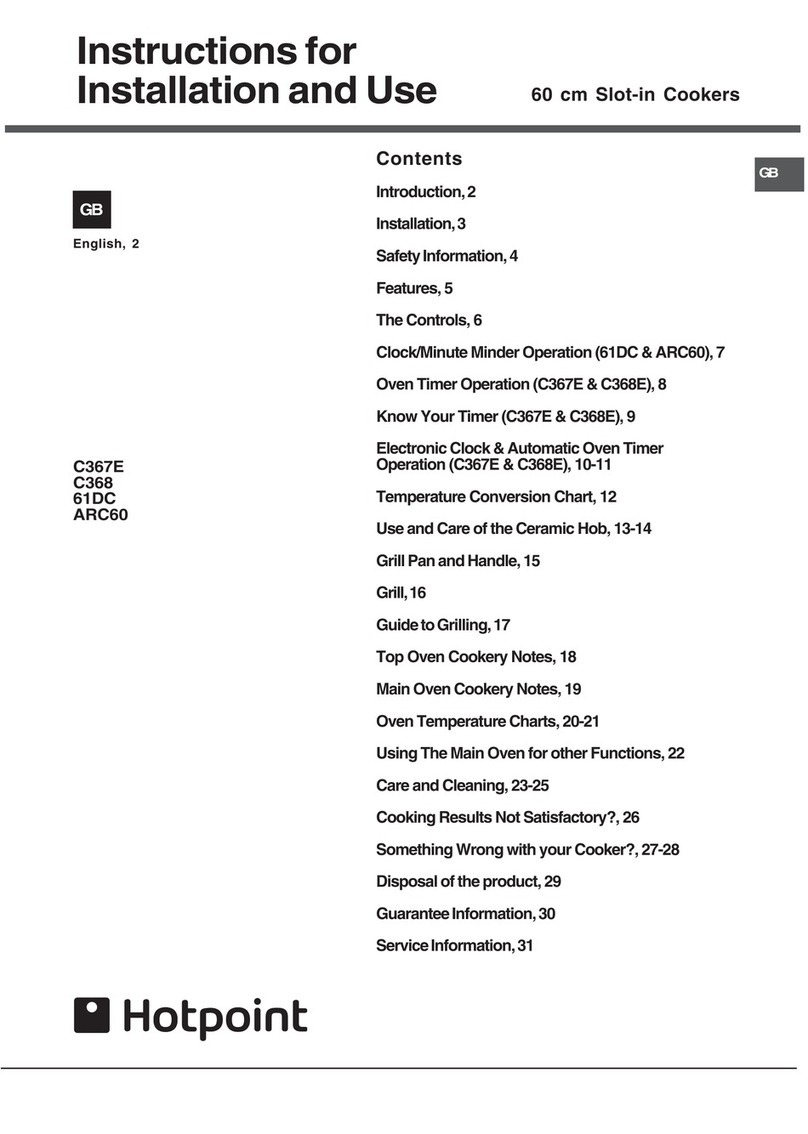
Hotpoint
Hotpoint C367E Instructions for installation and use

Metal Fusion
Metal Fusion King Kooker OUTDOOR COOKER Assembly and user's manual
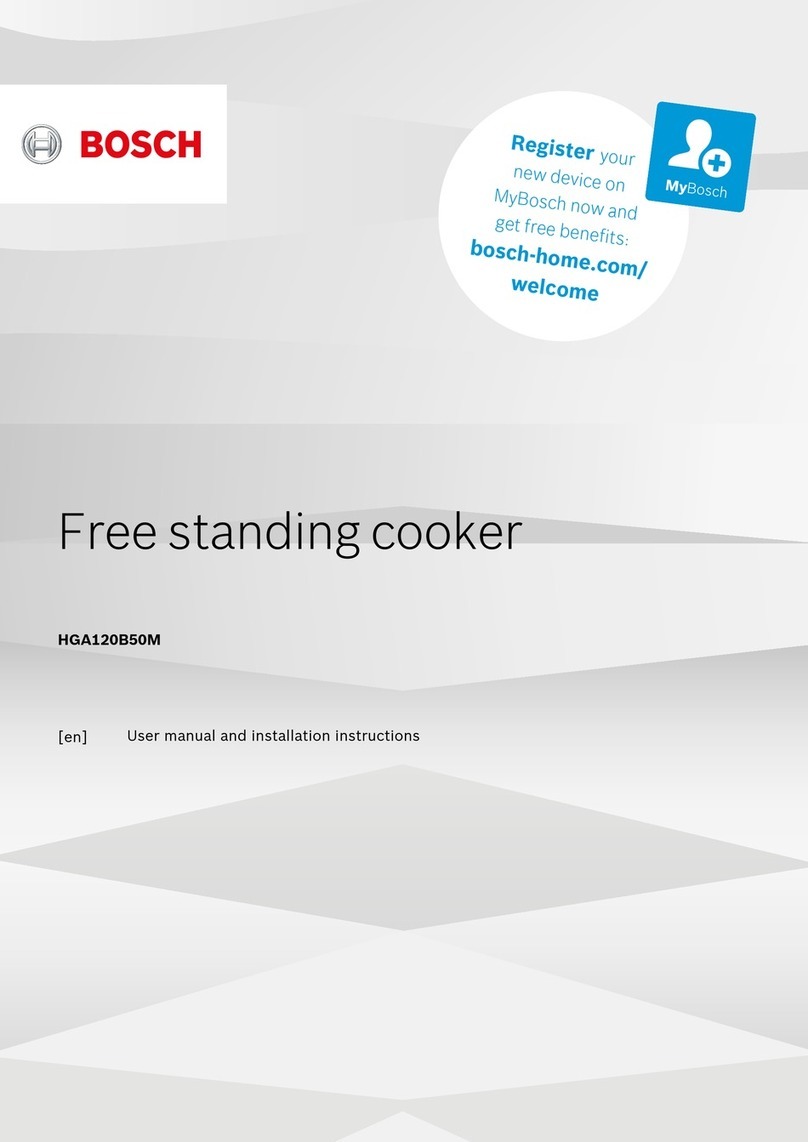
Bosch
Bosch HGA120B50M User manual and installation instructions

Electrolux
Electrolux EKC5044 user manual

